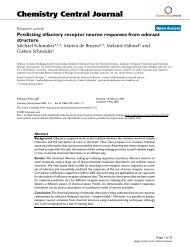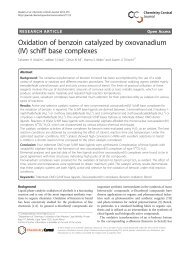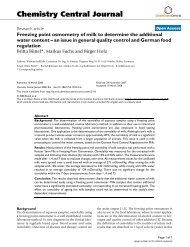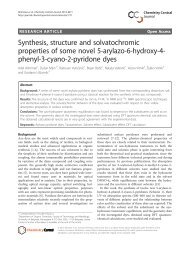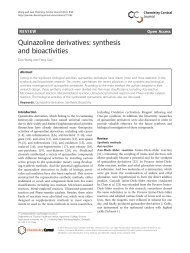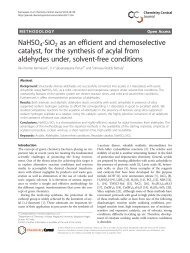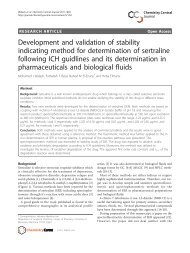PDF - Chemistry Central Journal
PDF - Chemistry Central Journal
PDF - Chemistry Central Journal
You also want an ePaper? Increase the reach of your titles
YUMPU automatically turns print PDFs into web optimized ePapers that Google loves.
Zucca et al. <strong>Chemistry</strong> <strong>Central</strong> <strong>Journal</strong> 2012, 6:161<br />
http://journal.chemistrycentral.com/content/6/1/161<br />
RESEARCH ARTICLE<br />
Open Access<br />
Degradation of textile dyes using immobilized<br />
lignin peroxidase-like metalloporphines under<br />
mild experimental conditions<br />
Paolo Zucca 1,2* , Antonio Rescigno 1 , Manuela Pintus 1 , Andrea C Rinaldi 1 and Enrico Sanjust 1<br />
Abstract<br />
Background: Synthetic dyes represent a broad and heterogeneous class of durable pollutants, that are released in<br />
large amounts by the textile industry. The ability of two immobilized metalloporphines (structurally emulating the<br />
ligninolytic peroxidases) to bleach six chosen dyes (alizarin red S, phenosafranine, xylenol orange, methylene blue,<br />
methyl green, and methyl orange) was compared to enzymatic catalysts. To achieve a green and sustainable<br />
process, very mild conditions were chosen.<br />
Results: IPS/MnTSPP was the most promising biomimetic catalyst as it was able to effectively and quickly bleach all<br />
tested dyes. Biomimetic catalysis was fully characterized: maximum activity was centered at neutral pH, in the<br />
absence of any organic solvent, using hydrogen peroxide as the oxidant. The immobilized metalloporphine kept a<br />
large part of its activity during multi-cycle use; however, well-known redox mediators were not able to increase its<br />
catalytic activity. IPS/MnTSPP was also more promising for use in industrial applications than its enzymatic<br />
counterparts (lignin peroxidase, laccase, manganese peroxidase, and horseradish peroxidase).<br />
Conclusions: On the whole, the conditions were very mild (standard pressure, room temperature and neutral pH,<br />
using no organic solvents, and the most environmental-friendly oxidant) and a significant bleaching and partial<br />
mineralization of the dyes was achieved in approximately 1 h. Therefore, the process was consistent with<br />
large-scale applications. The biomimetic catalyst also had more promising features than the enzymatic catalysts.<br />
Keywords: Biomimetic, Dye, Lignin-peroxidase, Porphine, Porphyrin<br />
Background<br />
Textile dyes are a broad and heterogeneous class of<br />
molecules used in many technological fields (i.e., textile<br />
and paper production, food technology, and hair coloring)<br />
[1]. Many chemical classes of synthetic dyes are frequently<br />
employed on an industrial scale; azo dyes,<br />
triarylmethanes, phenothiazine, and anthraquinones are<br />
among the most widespread [2,3].<br />
Because the goal of the dyeing process is color durability,<br />
textile dyes of all chemical classes are commonly<br />
highly resistant to both chemical and physical degradation.<br />
Accordingly, textile dyes represent a serious environmental<br />
concern because of their chemical inertness,<br />
high annual production (over 10,000 tons per year [1]),<br />
* Correspondence: pzucca@unica.it<br />
1 Dipartimento di Scienze Biomediche, Università di Cagliari, Cittadella<br />
Universitaria, 09042, Monserrato, CA, Italy<br />
2 Consorzio UNO (University of Oristano Consortium), Oristano, Italy<br />
toxicity/carcinogenicity [4,5], and the large amount of<br />
dyes released in industrial wastewaters (up to 50% of<br />
total process intake [6]).<br />
The European Directive 2002/61/EC forbids the use of<br />
some products (in particular some azo dyes). However,<br />
these restrictions only marginally solve the environmental<br />
problem because of the large volume of other dyes<br />
discharged every year.<br />
Several physical, chemical and enzymatic approaches<br />
have been proposed to remove dyes from industrial wastewaters<br />
[7-16] that require long reaction times, extreme<br />
operational conditions, and high costs [1]. Accordingly,<br />
the development of a clean and environmentally friendly<br />
process for removing dyes is a challenging issue, far<br />
from being solved.<br />
Redox-active metalloporphines are efficient catalysts;<br />
in the presence of a proper oxidant [17-21], they are able<br />
to oxidize many substrates, including several textile dyes,<br />
© 2012 Zucca et al.; licensee <strong>Chemistry</strong> <strong>Central</strong> Ltd. This is an Open Access article distributed under the terms of the Creative<br />
Commons Attribution License (http://creativecommons.org/licenses/by/2.0), which permits unrestricted use, distribution, and<br />
reproduction in any medium, provided the original work is properly cited.
Zucca et al. <strong>Chemistry</strong> <strong>Central</strong> <strong>Journal</strong> 2012, 6:161 Page 2 of 8<br />
http://journal.chemistrycentral.com/content/6/1/161<br />
under very mild conditions. We previously studied the<br />
ability of an immobilized manganese porphine to oxidize<br />
alizarin red S (ARS), an anthraquinone dye) [22], and<br />
phenosafranine (PNS), a phenylphenazinium dye [23],<br />
elucidating several aspects of the catalytic mechanism.<br />
In this study, we compare the catalysts IPS/MnTSPP<br />
and PP-PVA/FeTFPP (Figure 1), each containing a<br />
metalloporphine (Mn- and Fe-, respectively) immobilized<br />
onto a solid support, thus emulating ligninolytic<br />
peroxidases [24]. We investigated the ability of these two<br />
catalysts to oxidize different chemical classes of textile<br />
dyes in the presence of hydrogen peroxide under mild<br />
conditions. We also report the results of these catalysts<br />
on ARS and PNS to allow a comprehensive comparison.<br />
All the dyes included in the study are reported in<br />
Table 1.<br />
Results and discussion<br />
Comparison of IPS/MnTSPP and PP-PVA/FeTFPP<br />
We previously developed two biomimetic catalysts, IPS/<br />
MnTSPP and PP-PVA/FeTFPP, which are able to oxidize<br />
several lignin-model compounds. IPS/MnTSPP strictly<br />
emulates a lignin peroxidase (LiP) active site, having an<br />
imidazole-grafted support that coordinates a Mn(III)-<br />
porphine [24]. This catalyst showed a LiP-like activity,<br />
whereas, unlike an enzyme such as manganese peroxidase<br />
(MnP), it was not able to use the Mn 2+ ion as a<br />
redox mediator. Conversely, PP-PVA/FeTFPP was only<br />
“bioinspired” (i.e., only inspired by but not strictly emulating,<br />
a natural enzyme active site) because the metalloporphine<br />
was coordinated by a pyridine-grafted support<br />
[25] rather than imidazole, as in ligninolytic peroxidases.<br />
This catalyst showed both LiP-like and MnP-like catalytic<br />
activities.<br />
These two catalysts were tested for their ability to<br />
decolorize several textile dyes in the presence and absence<br />
of Mn 2+ using hydrogen peroxide as the oxidant<br />
in accordance with green chemistry principles [26]. The<br />
investigation employed very mild conditions (neutral pH<br />
and room temperature, using no organic solvents, and<br />
the most environmental-friendly oxidant) to serve as the<br />
basis for an environmentally sustainable textile wastewater<br />
treatment process.<br />
The results of these tests are reported in Table 2.<br />
Both biomimetic catalysts easily degraded all tested<br />
dyes, showing wide substrate specificity. As previously<br />
reported [24], the catalytic behavior of IPS/MnTSPP<br />
was not affected by the presence of Mn(II), showing<br />
similar bleaching percentages in both the presence and<br />
absence of this ion. All six dyes were rapidly bleached<br />
under the conditions studied; more than with a removal<br />
in all cases higher than 50% of each dye (up to ><br />
90% for PNS, MG, and MO) was removed in 1 h. In<br />
contrast, PP-PVA/FeTFPP was almost inactive in the<br />
absence of a suitable redox mediator. The conversion<br />
of all six dyes increased in the presence of Mn 2+ ,<br />
leading to values similar on average to those observed<br />
for IPS/MnTSPP.<br />
Considering that textile wastewaters do not usually<br />
contain manganous ion and that it would therefore be<br />
necessary to add Mn 2+ , itself a heavy metal pollutant,<br />
to the reaction, IPS/MnTSPP was considered the most<br />
promising catalyst for future industrial applications<br />
Hence, the rest of study focused on IPS/MnTSPP.<br />
The time dependence of dye bleaching by IPS/<br />
MnTSPP is shown in Figure 2. Note that most of the<br />
bleaching occurs in the first hour of the reaction, consistent<br />
with industrial timing needs.<br />
Figure 1 Proposed structure of the catalysts IPS/MnTSPP (a) and PP-PVA/FeTFPP (b). For more details, see: [24,25].
Zucca et al. <strong>Chemistry</strong> <strong>Central</strong> <strong>Journal</strong> 2012, 6:161 Page 3 of 8<br />
http://journal.chemistrycentral.com/content/6/1/161<br />
Table 1 The six textile dyes included in this study<br />
Alizarin Red S (ARS)<br />
Dye MW (g/mol) λ max (nm) ε (mol * L -1 *cm -1 )<br />
O<br />
O<br />
OH<br />
342.26 520 7200<br />
OH<br />
Phenosafranine (PNS)<br />
Cl -<br />
N<br />
322.80 520 32000<br />
H 2 N N + NH 2<br />
Xylenol Orange (XO)<br />
HO 3 S<br />
Na + 782.56 435 10500<br />
O<br />
O - O - O<br />
N<br />
O<br />
OH<br />
O - Na +<br />
N<br />
Na + O O<br />
O - Na +<br />
Methylene Blue (MB)<br />
N<br />
N<br />
S +<br />
Cl - 319.86 660 79500<br />
N<br />
Methyl Green (MG)<br />
472.51 632 55700<br />
N<br />
N + N +<br />
Cl -<br />
Cl -<br />
Methyl Orange (MO)<br />
N<br />
N<br />
N<br />
O O<br />
S<br />
O -<br />
Na + 327.34 464 24800
Zucca et al. <strong>Chemistry</strong> <strong>Central</strong> <strong>Journal</strong> 2012, 6:161 Page 4 of 8<br />
http://journal.chemistrycentral.com/content/6/1/161<br />
Table 2 Removal of the studied dyes in the presence of<br />
hydrogen peroxide and either IPS/MnTSPP or PP-PVA/<br />
FeTFPP, in both the presence and absence of Mn(II) as<br />
the redox mediator<br />
Mn(II) Catalyst Dyes removal % (1 h)<br />
ARS PNS XO MB MG MO<br />
No IPS/MnTSPP 62 ± 1 92 ± 2 42 ± 4 96 ± 4 82 ± 5 87 ± 2<br />
PP-PVA/FeTFPP n.d. n.d. n.d. n.d. n.d. n.d.<br />
Yes IPS/MnTSPP 55 ± 1 88 ± 2 44 ± 2 91 ± 3 77 ± 4 85 ± 4<br />
PP-PVA/FeTFPP 48 ± 3 58 ± 2 55 ± 5 37 ± 1 48 ± 2 91 ± 2<br />
The reaction mixtures contained 5 mg of catalyst in 1 mL of 25 mM buffer<br />
solution containing 8.8 mM hydrogen peroxide and a proper concentration of<br />
the selected dyes (0.29 mM ARS, 0.31 mM PNS, 2 mM XO, 0.15 mM MB,<br />
1.5 mM MG, and 1.25 mM MO). Quantification of the removed dye was<br />
obtained photometrically, using the λ max and molar extinction coefficients<br />
reported in Table 1. n.d.: not detectable. (n = 4).<br />
Characterization of bleaching by IPS/MnTSPP and H 2 O 2<br />
IPS/MnTSPP catalysis was strongly pH-dependent; an<br />
approximately neutral pH was optimal for all dyes tested<br />
except XO and PNS, which had optimal bleaching at pH<br />
6 and 8, respectively (data not shown). However, XO<br />
and PNS were sufficiently bleached at pH 7 that IPS/<br />
MnTSPP remains a viable catalyst for environmentally<br />
friendly wastewater treatment.<br />
An exhaustive kinetic modeling of this catalysis is beyond<br />
the scope of our work. However, the decolorization<br />
of all six dyes apparently followed saturation Michaelis-<br />
Menten-like kinetics, allowing the calculation of catalytic<br />
parameters (Table 3). Reported Michaelis constants (K M )<br />
showed that IPS/MnTSPP had significantly higher affinity<br />
for cationic dyes than anionic dyes (lower K M for<br />
Figure 2 Time dependence of dye removal in the presence of<br />
IPS/MnTSPP and hydrogen peroxide. The reaction mixtures<br />
contained 5 mg of catalyst in 1 mL of 25 mM buffer solution<br />
containing 8.8 mM hydrogen peroxide and a proper concentration<br />
of the selected dyes (0.29 mM ARS, 0.31 mM PNS, 2 mM XO,<br />
0.15 mM MB, 1.5 mM MG, and 1.25 mM MO). Quantification of the<br />
dyes was obtained photometrically, using the λ max and molar<br />
extinction coefficients reported in Table 1.<br />
PNS and MB, higher K M for ARS and XO). This lower<br />
affinity led to the lowest bleaching rate for XO and ARS<br />
(compare Figure 2). Notably, in all cases, K M values were<br />
in the millimolar range and did not suffer from substrate<br />
inhibition. This can be a crucial issue for potential industrial<br />
applications because some bleaching approaches<br />
(i.e., enzymatic, vide ultra) are not able to work at these<br />
concentrations.<br />
To test the hypothesis of a one-electron abstraction<br />
mechanism as the first step of the bleaching process, the<br />
influence of several well-known redox mediators was<br />
also studied: 4-hydroxy-2,2,6,6-tetramethylpiperidine-1-<br />
oxyl (OH- TEMPO), N-hydroxyphthalimide (NPH), N-<br />
hydroxysuccinimide (NHS), and N-hydroxybenzotriazole<br />
(NHT). The results are summarized in Table 4. Only in<br />
the case of MG was an increase (three-fold) of the catalytic<br />
activity observed; in all the other cases, the redoxmediators<br />
mainly decreased IPS/MnTSPP catalysis (this<br />
quenching could be due to the lower reactivity of the<br />
oxygen-centered radical form of these mediators). Even<br />
in the best case, however, because the increase in catalytic<br />
activity was moderate, the industrial benefit of these<br />
redox mediators may not justify their environmental<br />
impact.<br />
The catalyst was also investigated for its reuse potential.<br />
The results are reported in Table 5. On average, a<br />
rapid decrease of catalytic activity was observed in the<br />
first 2–3 cycles. Subsequently, activity was stable at approximately<br />
25-30% of maximum for at least 8–10 cycles.<br />
A potential explanation for this pattern is the possibility<br />
that a fraction of some dyes remains tightly adsorbed on<br />
the catalyst even when the supernatant is completely<br />
decolorized. This adsorbed dye would likely reduce the<br />
catalytic performance by steric hindrance and/or electrostatic<br />
repulsion of incoming substrate molecules. Nevertheless,<br />
the catalyst keeps a significant part of its<br />
catalytic activity during multi-cycle employment. This is<br />
an important quality for large-scale applications.<br />
Significant removal of total organic carbon (TOC) was<br />
also observed during the bleaching by H 2 O 2 /IPS/<br />
MnTSPP, as shown in Figure 3. In the case of ARS, PNS,<br />
and MB, over 50% of TOC removal was observed in<br />
24 hours, whereas lower decreases were recorded for<br />
XO and MG. Conversely, in the case of MO no TOC<br />
modification occurred during the catalysis. These results<br />
suggest that a decarboxylative degradation occurred for<br />
some of the dyes, whose TOC values decreased significantly<br />
during the bleaching experiments.<br />
IPS/MnTSPP was also tested for its ability to decolorize<br />
a complex mixture of all the six dyes, emulating realistic<br />
textile plant waste. The six dyes were each present<br />
in the saturating concentrations used above, leading to<br />
high impacting TOC (approximately 1580 mg/L). The<br />
changes in the UV–vis spectra (Figure 4) show a
Zucca et al. <strong>Chemistry</strong> <strong>Central</strong> <strong>Journal</strong> 2012, 6:161 Page 5 of 8<br />
http://journal.chemistrycentral.com/content/6/1/161<br />
Table 3 Kinetic parameters measured for the bleaching of each dye by IPS/MnTSPP and hydrogen peroxide<br />
Sub-strate Kinetic parameter Dye<br />
ARS PNS XO MB MG MO<br />
Reducing substrate K M (mM) 2.11 ± 0.74 0.32 ± 0.04 1.33 ± 0.38 0.11 ± 0.02 0.72 ± 0.12 0.63 ± 0.05<br />
k cat (min -1 ) 0.14 ± 0.03 2.2 ± 0.1 98 ± 14 19.0 ± 1.8 108 ± 9 67 ± 4<br />
k cat /K M (mM -1 min -1 ) 0.066 ± 0.037 7.0 ± 1.2 74 ± 31 166 ± 52 150 ± 37 105 ± 16<br />
H 2 O 2 K M (mM) 3.21 ± 0.12 3.0 ± 0.4 7.9 ± 1.9 2.4 ± 0.5 0.43 ± 0.08 7.4 ± 1.5<br />
k cat (min -1 ) 0.13 ± 0.01 1.9 ± 0.1 78 ± 8.9 15.2 ± 1.3 159 ± 12 71 ± 8<br />
k cat /K M (mM -1 min -1 ) 0.040 ± 0.004 0.63 ± 0.13 9.9 ± 3.6 6.4 ± 2.1 369 ± 100 9.6 ± 3.2<br />
Data for ARS and PNS were previously reported and are added here to allow a full comparison [22,23] (n = 5).<br />
significant decolorization, although with a slower kinetics<br />
(approximately 5 hours for a 50% decrease of the main<br />
visible peak). However, the feasibility of using this<br />
treatment in an industrial process was confirmed by a<br />
significant TOC decrease (approximately 20%) in the<br />
same time frame.<br />
Comparison with enzymatic bleaching<br />
A full comparison with the enzymatic bleaching of the<br />
dyes was also performed. The ligninolytic enzymes<br />
tested were laccase (LC), lignin peroxidase, and the nonligninolytic<br />
enzyme horseradish peroxidase (HRP). In<br />
addition, Mn(III) was also used as oxidizing agent, mimicking<br />
manganese peroxidase action [27]. These biological<br />
catalysts suffered from significant substrate<br />
inhibition, preventing their use at the dye concentrations<br />
used for IPS/MnTSPP. Usually, concentrations of dyes at<br />
least of one order of magnitude lower were necessary.<br />
These enzymes also suffer from H 2 O 2 inhibition,<br />
needing lower concentrations of oxidizing substrate.<br />
Accordingly, under the same conditions, it is not surprising<br />
that enzymatic bleaching efficiency was significantly<br />
lower than IPS/MnTSPP bleaching efficiency<br />
(
Zucca et al. <strong>Chemistry</strong> <strong>Central</strong> <strong>Journal</strong> 2012, 6:161 Page 6 of 8<br />
http://journal.chemistrycentral.com/content/6/1/161<br />
Figure 3 Total organic carbon (TOC) decrease during the bleaching of the textile dyes by IPS/MnTSPP (n = 3).<br />
Laccase from Pleurotus sajor-caju was purified through<br />
two chromatographic steps (details in [28,29]).<br />
Spectrophotometric measurements were carried out<br />
with an UltroSpec 2100pro (Amersham Bioscience).<br />
Concentrations of the substrates were also measured by<br />
UV-HPLC and GC-MS, using previously described<br />
methods [30,31].<br />
Preparation of IPS/MnTSPP<br />
The complex IPS/MnTSPP was synthesized as previously<br />
described [24]. Briefly, 10 g plain silica gel was<br />
functionalized by overnight reaction at 80°C with<br />
10 mmol 3-(1-imidazolyl)propylcarbamoyl-3’-aminopropyltriethoxysilane<br />
solubilized in 10 mL dioxane, in the<br />
presence of 10 μL N-methylmorpholine acting as the<br />
catalyst. The activated silica (IPS) was washed consecutively<br />
with 0.5 M HCl, H 2 O, 0.1 M NaOH and<br />
H 2 O again. The wet silica was then carefully dried<br />
overnight in a vacuum oven.<br />
The bound MnTSPP was quantified by the difference<br />
in absorption at 400 nm (the λ max of the MnTSPP Soret<br />
band), as described in [24].<br />
Preparation of PP-PVA/FeTFPP<br />
The complex PP-PVA/FeTFPP was synthesized as previously<br />
described [25]. Briefly, 1 g of aminopropyl crosslinked<br />
Figure 4 Changes in UV–vis spectra during the bleaching of a mix of the six studied dyes by IPS/MnTSPP.
Zucca et al. <strong>Chemistry</strong> <strong>Central</strong> <strong>Journal</strong> 2012, 6:161 Page 7 of 8<br />
http://journal.chemistrycentral.com/content/6/1/161<br />
Table 6 Enzymatic bleaching of the dyes<br />
Dye LC LC + H 2 O 2 HRP LiP Mn 3+<br />
ARS + ++ +/− +/− +<br />
PNS - - - +/− -<br />
XO + + + - +<br />
MB - +/− +/− +/− -<br />
MG + + ++ +/− ++<br />
MO + +/− + +/− +<br />
In the conditions tested, ligninolytic enzymes present a narrower substrate<br />
specificity towards the dyes included in this study than IPS/MnTSPP. Legend:<br />
LC laccase, HRP horseradish peroxidase, LiP lignin peroxidase, ++ good<br />
substrate (complete bleaching < 1 h), + substrate, +/− weak substrate<br />
(bleaching < 10% in 24 h), - no substrate.<br />
PVA (prepared as in [32]) was suspended in an excess of<br />
0.05 M sodium acetate buffer pH 5, and treated with<br />
0.1 mL 4-pyridinecarboxaldehydeand0.5gsodiumcyanoborohydride.<br />
After 24 h of incubation at 25°C, the support<br />
was exhaustively washed with water, and dried at 50°C, to<br />
obtain PP-PVA. One-gram aliquots of PP-PVA were treated<br />
with 20 mg of FeTFPP, solubilized in 10 mL DMSO. The<br />
slurries were kept stirring in the dark for 24 h, washed exhaustively<br />
with DMSO, and carefully dried at 50°C.<br />
Bound metalloporphine was quantified by difference<br />
through spectrophotometric measurement at 411 nm<br />
(ε 411 = 115,000 M -1 cm -1 in DMSO) [25].<br />
Activity measurements<br />
Routine measurements of the catalytic activity of immobilized<br />
metalloporphines were performed through spectrophotometric<br />
assays. The suspension contained 5 mg<br />
of catalyst in 1 mL of 25 mM buffer solution containing<br />
8.8 mM hydrogen peroxide and a proper concentration<br />
of the selected dye. The routine analyses were performed<br />
using the following concentrations of dyes (chosen to be<br />
only slightly higher than respective K M , to better observe<br />
influences on catalytic activity): 0.29 mM ARS, 0.31 mM<br />
PNS, 2 mM XO, 0.15 mM MB, 1.5 mM MG, and<br />
1.25 mM MO. During the kinetic experiments, wide ranges<br />
of substrate concentrations were studied (0.01-2 mM for<br />
the dyes, 0.1-40 mM for hydrogen peroxide).<br />
The reaction mixture was then stirred at 25°C in the<br />
dark, and the reaction was monitored photometrically<br />
using the λ max and molar extinction coefficients,<br />
reported in Table 1.<br />
The actual hydrogen peroxide concentration was<br />
determined by KMnO 4 titration.<br />
When the reaction pH was not 7, the pH was corrected<br />
to 7 with 0.1 mL of potassium phosphate buffer<br />
1 M (pH 7) before an absorbance measurement.<br />
UV–vis spectra in the range 230–700 nm were also<br />
recorded. Different McIlvaine buffers were used in<br />
the pH range 3–8.<br />
When used, redox mediators (4-hydroxy-2,2,6,6-tetramethylpiperidine-1-oxyl<br />
OH- TEMPO; N-hydroxyphthalimide<br />
NPH; N-hydroxysuccinimide NHS; and<br />
N-hydroxybenzotriazole NHT) were added to the reaction<br />
medium at a final concentration of 1 mM. For<br />
the MnP-like assays, all the experiments were repeated<br />
as above in the presence of 1 mM MnSO 4 and 50 mM<br />
malonic acid. During multi-cyclic runs, the catalysts were<br />
regenerated between consecutive cycles by repeated<br />
washings with water and 2-propanol and by drying at 50°C.<br />
Total organic carbon determination was performed by<br />
automatic analyzer TOC 5000A (Shimadzu), equipped with<br />
Pt-Al 2 O 3 oxidizing catalyst. The volume of injection was 25<br />
μL. The calibration curve was obtained using a range of<br />
standard solutions of potassium phthalate (0–200 ppm).<br />
Michaelis-Menten kinetic parameters were calculated<br />
by using R 2.5.1 software (R Foundation for Statistical<br />
Computing, Vienna).<br />
Enzymatic assays<br />
When horseradish peroxidase (HRP) was used, up to 20<br />
E.U. were present in a final volume of 1 mL of 25 mM<br />
buffer (pH 4, 5, 6, or 7) with 8.8 mM H 2 O 2 . Due to significant<br />
substrate inhibition, lower dyes concentrations<br />
were used: 119 μM ARS; 31 μM PNS; 200 μM XO;<br />
15 μM MB; 150 μM MG; 65 μM MO.<br />
The same conditions were adopted for the experiments<br />
with laccase (23 E.U. added); every experiment<br />
was performed in the presence and absence of H 2 O 2 .<br />
In the case of lignin peroxidase (LiP), 0.2 E.U. were<br />
present in the final volume of 1 mL, with 0.176 mM<br />
H 2 O 2, due to strong substrate inhibition.<br />
Moreover, to mimic manganese peroxidase (MnP) action,<br />
other experiments were conducted using Mn(III) as the putative<br />
oxidizing agent. One mM manganese triacetate was<br />
dissolved in 50 mM sodium malonate buffer, pH 6.5 [27],<br />
and the final mixture contained this solution along with<br />
dyes at the same concentrations, as mentioned above.<br />
Conclusion<br />
IPS/MnTSPP has proved able to efficiently degrade all<br />
tested dyes, regardless of their chemical class, under very<br />
mild conditions: standard pressure, room temperature<br />
and neutral pH, using no organic solvents, and the most<br />
environmental-friendly oxidant. The yields and time<br />
requirements of the process were quite promising for a<br />
potential industrial application. Furthermore, a multicycle<br />
capability was described, even if only 30% of catalytic<br />
activity is retained for 8–10 cycles.<br />
In comparison to enzymatic systems, the biomimetic<br />
catalyst was more efficient and had wider substrate specificity.<br />
Therefore, after proper optimization of the process,<br />
this catalyst is worth consideration as a possible medium/<br />
large scale application in textile wastewater treatment.
Zucca et al. <strong>Chemistry</strong> <strong>Central</strong> <strong>Journal</strong> 2012, 6:161 Page 8 of 8<br />
http://journal.chemistrycentral.com/content/6/1/161<br />
Abbreviations<br />
ARS: Alizarin Red S; FeTFPP: 5,10,15,20-tetrakis(pentafluorophenyl)<br />
porphine-iron(III) chloride; IPS: (3-Imidazolylpropylcarbamoyl)-3’-<br />
aminopropylsilica; HRP: Horseradish peroxidase; LC: Laccase; LiP: Lignin<br />
peroxidase; MB: Methylene Blue; MG: Methyl Green; MnTSPP: 5,10,15,<br />
20-tetrakis(4-sulfonato-phenyl)porphine-Mn(III) chloride; MO: Methyl Orange;<br />
MnP: Manganese peroxidase; PP-PVA: 4’-Pyridylmethyl-3-aminopropylfunctionalized;<br />
PNS: Phenosafranine; PVA: Crosslinked with glutaraldehyde;<br />
TOC: Total organic carbon; XO: Xylenol Orange.<br />
Competing interests<br />
The authors declare that they have no competing interests.<br />
Authors’ contributions<br />
PZ performed the main part of the experiments and drafted the manuscript.<br />
MP performed TOC and enzymatic assays. ACR, and AR helped analyzing the<br />
data and draft the manuscript. ES conceived the study, coordinated the<br />
study, and worked on data analysis and interpretation. All the authors read<br />
and approved the final manuscript.<br />
Acknowledgments<br />
This research was partly funded by Fondazione Banco di Sardegna (Project<br />
Code 861/2012) and Regione Autonoma Sardegna (PO Sardegna FSE 2007–<br />
2013, L.R.7/2007, Bando Giovani Ricercatori, Project CRP1_27, and PO<br />
Sardegna FSE 2007–2013, L.R.7/2007, Ricerca di Base Bando 2008, Project<br />
CRP1_408).<br />
Received: 22 October 2012 Accepted: 19 December 2012<br />
Published: 20 December 2012<br />
References<br />
1. Forgacs E, Cserhati T, Oros G: Removal of synthetic dyes from<br />
wastewaters: a review. Environ Int 2004, 30:953–971.<br />
2. Azizi A, Moghaddam MRA, Arami M: Application of wood waste for removal of<br />
reactive blue 19 from aqueous solutions: optimization through response<br />
surface methodology. Environ Eng Manag J 2012, 11:795–804.<br />
3. Brînzilă CI, Ciobanu R, Brillas E: Effect of experimental parameters on<br />
crystal violet mineralization by electro-fenton processes.<br />
Environ Eng Manag J 2012, 11:517–523.<br />
4. Tsuda S, Murakami M, Matsusaka N, Kano K, Taniguchi K, Sasaki YF: DNA<br />
Damage induced by red food dyes orally administered to pregnant and<br />
male mice. Toxicol Sci 2001, 61:92–99.<br />
5. Walthall WK, Stark JD: The acute and chronic toxicity of two xanthene<br />
dyes, fluorescein sodium salt and phloxine B, to Daphnia pulex.<br />
Environ Pollut 1999, 104:207–215.<br />
6. Pierce J: Colour in textile effluents - the origins of the problem.<br />
J Soc Dye Colour 1994, 110:131–133.<br />
7. Colar LA, Ilinoiu EC, Manea F, Pode R, Lazau C: Photocatalytic activity of a<br />
silver doped TIO 2 modified zeolite in the degradation of reactive yellow<br />
125 azo dye. Environ Eng Manag J 2012, 11:61–68.<br />
8. Zucca P, Rescigno A, Olianas A, Maccioni S, Sollai F, Sanjust E: Induction,<br />
purification, and characterization of a laccase isozyme from Pleurotus<br />
sajor-caju and the potential in decolorization of textile dyes.<br />
J Mol Catal B Enzym 2011, 68:216–222.<br />
9. Pakshirajan K, Jaiswal S, Das RK: Biodecolourization of azo dyes using<br />
phanerochaete chrysosporium: effect of culture conditions and enzyme<br />
activities. J Sci Ind Res 2011, 70:987–991.<br />
10. Córdoba A, Magario I, Ferreira ML: Experimental design and MM2-PM6<br />
molecular modelling of hematin as a peroxidase-like catalyst in Alizarin<br />
Red S degradation. J Mol Catal A Chem 2012, 355:44–60.<br />
11. Zhu L, Ghosh T, Park CY, Meng ZD, Oh WC: Enhanced sonocatalytic<br />
degradation of rhodamine B by graphene-TiO 2 composites synthesized<br />
by an ultrasonic-assisted method. Chin J Catal 2012, 33:1276–1283.<br />
12. OhWC,ChenM,ChoK,KimC,MengZ,ZhuL:Synthesis of graphene-CdSe<br />
composite by a simple hydrothermal method and its photocatalytic<br />
degradation of organic dyes. Chin J Catal 2011, 32:1577–1583.<br />
13. Asgher M, Kamal S, Iqbal HMN: Improvement of catalytic efficiency, thermostability<br />
and Dye decolorization capability of pleurotus ostreatus IBL-02<br />
laccase by hydrophobic Sol Gel entrapment. Chem Centr J 2012, 110.<br />
14. Stengl V, Matys Grygar T, Henych J, Kormunda M: Hydrogen peroxide<br />
route to Sn-doped titania photocatalysts. Chem Centr J 2012, 113.<br />
15. Velmurugan R, Sreedhar B, Swaminathan M: Nanostructured AgBr loaded<br />
TiO 2: an efficient sunlight active photocatalyst for degradation of<br />
reactive Red 120. Chem Centr J 2011, 5.<br />
16. Chiavola A: Textiles. Water Environ Res 2012, 84:1511–1532.<br />
17. Zucca P, Rescigno A, Sanjust E: Ligninolytic peroxidase-like activity of a<br />
synthetic metalloporphine immobilized onto mercapto-grafted<br />
crosslinked PVA inspired by the active site of cytochrome P450.<br />
Chin J Catal 2011, 32:1663–1666.<br />
18. Faria AL, Mac Leod TOC, Barros VP, Assis MD: Hydrocarbon oxidation<br />
catalyzed by iron and manganese porphyrins anchored on<br />
aminofunctionalized supports. J Brazil Chem Soc 2009, 20:895–906.<br />
19. Dos Santos JS, Faria AL, Da Silva Amorin PM, La Luna FM, Caiado KL,<br />
Silva DOC E, Sartoratto PPC, Assis MD: Iron(III) porphyrin covalently<br />
supported onto magnetic amino-functionalized nanospheres as catalyst<br />
for hydrocarbon and herbicide oxidations. J Brazil Chem Soc 2012,<br />
23:1411–1420.<br />
20. Díaz-Díaz G, Blanco-López MC, Lobo-Castañón MJ, Miranda-Ordieres AJ,<br />
Tuñón-Blanco P: Hemo-acrylic polymers as catalyst for the oxidative<br />
dehalogenation of 2,4,6-trichlorophenol. Chloroperoxidase’s mimic<br />
imprinting effects. J Mol Catal A Chem 2012, 353–354:117–121.<br />
21. Tian P, Gao B, Chen Y: Synchronous synthesis and immobilization of<br />
pyridyl porphyrins on crosslinked polystyrene microspheres and catalytic<br />
oxidation performance of immobilized cationic Co-porphyrins.<br />
Chin J Catal 2011, 32:483–489.<br />
22. Zucca P, Vinci C, Sollai F, Rescigno A, Sanjust E: Degradation of Alizarin<br />
Red S under mild experimental conditions by immobilized 5,10,15,20-<br />
tetrakis(4-sulfonatophenyl)porphine-Mn(III) as a biomimetic peroxidaselike<br />
catalyst. J Mol Catal A Chem 2008, 288:97–102.<br />
23. Zucca P, Vinci C, Rescigno A, Dumitriu E, Sanjust E: Is the bleaching of<br />
phenosafranine by hydrogen peroxide oxidation catalyzed by silicasupported<br />
5,10,15,20-tetrakis-(sulfonatophenyl)porphine-Mn(III) really<br />
biomimetic? J Mol Catal A Chem 2010, 321:27–33.<br />
24. Zucca P, Mocci G, Rescigno A, Sanjust E: 5,10,15,20-Tetrakis(4-sulfonatophenyl)porphine-Mn(III)<br />
immobilized on imidazole activacted silica as a<br />
novel lignin-peroxidase-like biomimetic catalyst. J Mol Catal A Chem 2007,<br />
278:220–227.<br />
25. Zucca P, Sollai F, Garau A, Rescigno A, Sanjust E: Fe(III)-5,10,15,20-Tetrakis<br />
(pentafluorophenyl)porphine supported on pyridyl-functionalized,<br />
crosslinked poly(vinylalcohol) as a biomimetic versatile-peroxidase-like<br />
catalyst. J Mol Catal A Chem 2009, 306:89–96.<br />
26. Cojocariu AM, Mutin PH, Dumitriu E, Vioux A, Fajula F, Hulea V: Removal of<br />
dimethylsulfoxide from wastewater using mild oxidation with H 2 O 2 over<br />
Ti-based catalysts. Chemosphere 2009, 77:1065–1068.<br />
27. Wariishi H, Valli K, Gold MH: Manganese(II) oxidation by manganese peroxidase<br />
from the basidiomycete phanerochaete-chrysosporium - kinetic mechanism<br />
and role of chelators. JBiolChem1992, 267:23688–23695.<br />
28. Rescigno A, Zucca P, Flurkey A, Inlow J, Flurkey WH: Identification and<br />
discrimination between some contaminant enzyme activities in<br />
commercial preparations of mushroom tyrosinase. Enzyme Microb Technol<br />
2007, 41:620–627.<br />
29. Sollai F, Zucca P, Sanjust E, Steri D, Rescigno A: Umbelliferone and<br />
esculetin: inhibitors or substrates for polyphenol oxidases?<br />
Biol Pharm Bull 2008, 31:2187–2193.<br />
30. Zucca P, Littarru M, Rescigno A, Sanjust E: Cofactor recycling for selective<br />
enzymatic biotrasformation of cinnamaldehyde to cinnamyl alcohol.<br />
Biosci Biotechnol Biochem 2009, 73:1224–1226.<br />
31. Rescigno A, Casañola-Martin GM, Sanjust E, Zucca P, Marrero-Ponce Y:<br />
Vanilloid derivatives as tyrosinase inhibitors driven by virtual screeningbased<br />
QSAR models. Drug Test Anal 2011, 3:176–181.<br />
32. Sanjust E, Cocco D, Curreli N, Rescigno A, Sollai F, Bannister JV: Flavingrafted<br />
poly(vinyl alcohol): preparation and properties. J Appl Polym Sci<br />
2002, 85:2471–2477.<br />
doi:10.1186/1752-153X-6-161<br />
Cite this article as: Zucca et al.: Degradation of textile dyes using<br />
immobilized lignin peroxidase-like metalloporphines under mild<br />
experimental conditions. <strong>Chemistry</strong> <strong>Central</strong> <strong>Journal</strong> 2012 6:161.





